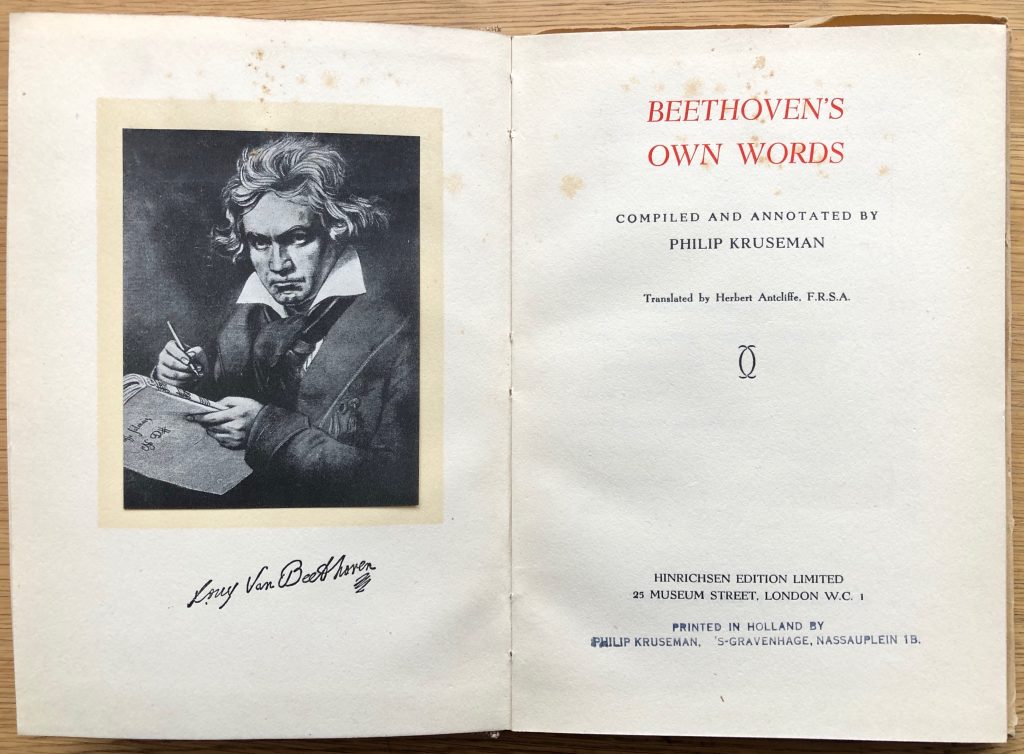Think about stories…
“Think about stories
with reason and rhyme
Circling through your brain…”
My favourite lines from Saturday Sun – the perfect song for long hot summer days courtesy of the great Nick Drake.
content-page.php --c
“Think about stories
with reason and rhyme
Circling through your brain…”
My favourite lines from Saturday Sun – the perfect song for long hot summer days courtesy of the great Nick Drake.
content-page.php --c
For less than the price of a Starbucks latte (other brands are available), I bought from a charity shop Beethoven’s Own Words – “a little book,” as the compiler Philip Kruseman describes it, “in which a choice of thoughts and expressions of the greatest among the great tone poets is collected”:

This little book is indeed packed full of choice thoughts and expressions. Here’s my favourite:
“Good song has been my guide; I have tried to write as fluently as possible, and I dare to answer for this before the judgement seat of healthy intelligence and good taste.”
An encouragement to make our words sing, from the great master of organised sound.
content-page.php --c
In a Norwich charity shop not so long ago I picked up, for £2.99 (c$4), a copy of Herbert J. C. Grierson’s Rhetoric and English Composition. Published back in 1944, it is full of insights that still hold true. Insights such as this one, in the chapter on The Choice of Words: “To the poet and orator [words] are living things, the winged messengers of their thoughts and feelings, and like the birds they have three properties – body or meaning, colour, and music.”
Alongside their dictionary definition (their meaning), words also have colour “the associations which gather around a word by long usage”, and music – their melody and rhythm. Taking all three together, every word has the potential to make us think, and feel, and hear different things.
This is powerful stuff. In choosing the right words to tell our stories, we can play with all three properties – meaning and colour and music – to appeal to the head and the heart and the ears. So our stories not only convey clearly, but feel right and sound good, too.
content-page.php --c
On a recent trip to LA, I was held captive in a quiet corner of The Broad by William Kentridge’s brilliant Second-Hand Reading. In six or so minutes of animated words, images and music, the work takes you on a magical journey which is both substantial and light-touched, heavy-souled and uplifting. I happily watched it again and again, each time sensing something new in the looping lyrical storytelling.
In a TEDx talk, William Kentridge describes how “ideas come into the studio and meet charcoal, paper, ink…” This fluid, handmade “thinking in material” is core to his art. And so, in turn, is the task “to find the less good idea. One knows the danger of confident men with their good ideas, and the damage this does every time. Give yourself over to the logic of the material… The main idea gets pushed to the side and other things emerge from the process of working… the less good ideas… This is key in the studio – to allow a space for this to emerge… to allow the studio to be a safe space for stupidity…”
So for anyone struck dumb by the terrors of the blank page, or indeed convinced of the perfection of their opening line, take a leaf out of Mr Kentridge’s book. Start writing. Be stupid. Goof about a bit. Get your hands inky. The less good ideas will emerge, and who knows – they may well prove to be great.